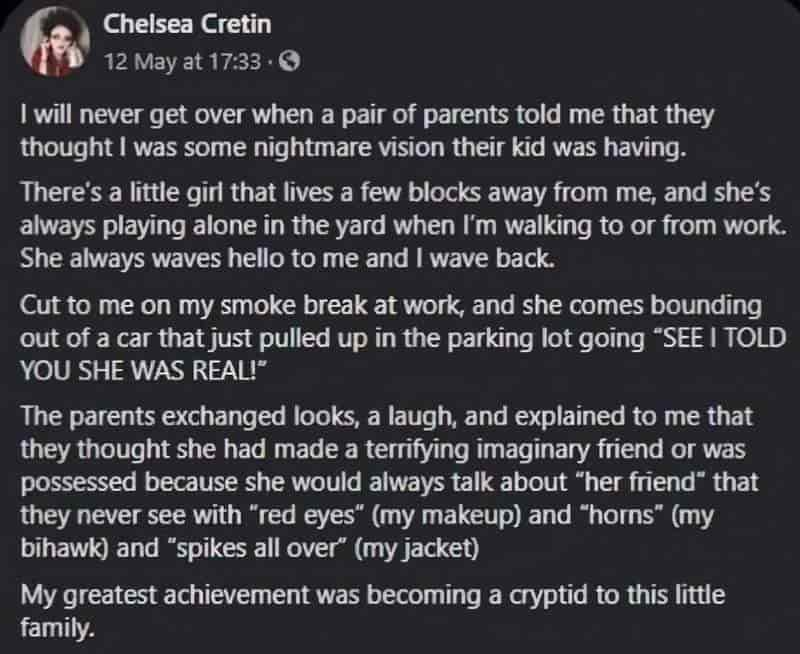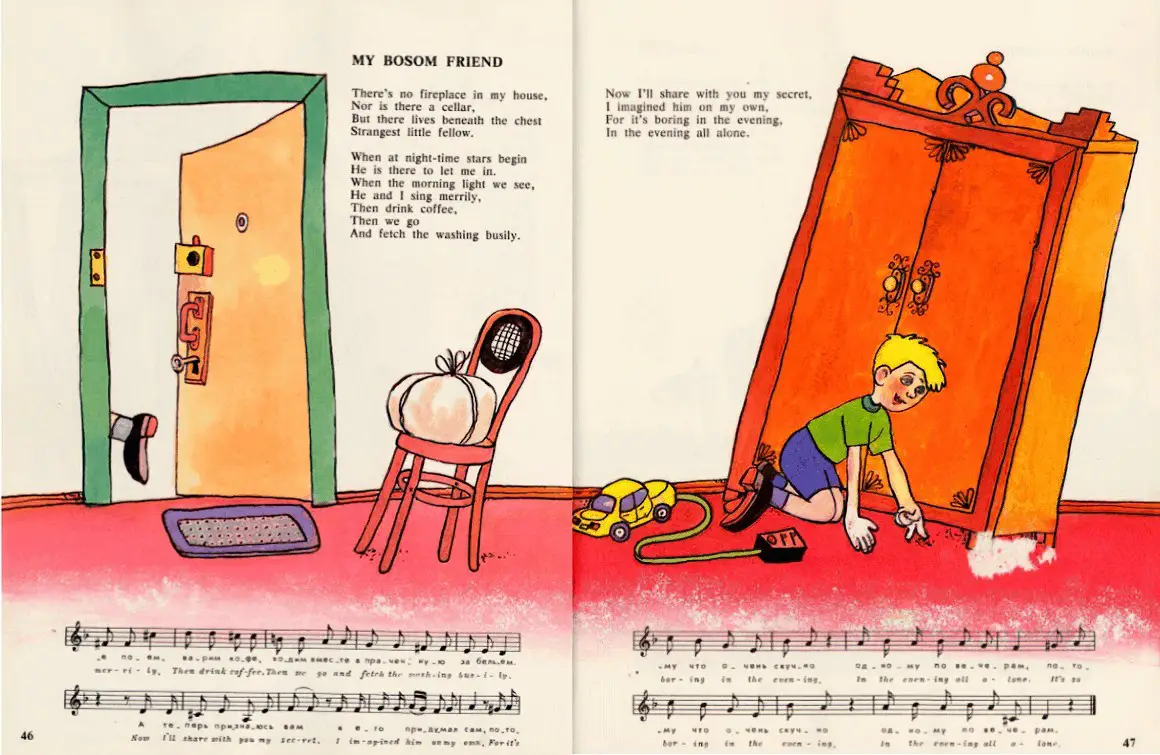Hear “The People Across The Canyon” (1964) read by Douglass Greene at Alfred Hitchcock’s Mystery Magazine.
This is my favourite story from the excellent collection Troubled Daughters, Twisted Wives, partly due to how much I relate to the characters. When our daughter was five some new neighbours moved in next door. The adults were super unfriendly, but had two sons who were overly friendly. They would invite our daughter next door, but oftentimes she came back subdued, and once, crying. I never knew what happened next door, but I did learn more and more about the family, and had to stop my daughter from going over there. When you’re the parent of a child between around 4-8, it’s difficult to discern fact from fiction; children so often live in their own worlds. “The People Across The Canyon” encapsulates that confusion most beautifully.

WHAT HAPPENS IN “THE PEOPLE ACROSS THE CANYON”
A family of two parents and their 8-year-old daughter live in a house on the edge of a Canyon. The parents enjoy solitude. But one day, it appears a new family has moved into the house right across the canyon.
The 8-year-old starts talking about them, and has obviously been to visit them. She even points them out in town, driving in a cream sports car.
When the 8-year-old tells her parents that the Smiths would like to keep her for their own, the father thinks enough is enough, and they go to the house to confront the newcomers.
We learn at this point, though it has been foreshadowed all along, that Cathy has made these people up completely. What they thought was a television set glowing is actually a mirror, reflecting light.
SETTING OF “THE PEOPLE ACROSS THE CANYON”
You won’t be surprised to hear that Margaret Millar was born and bred in Ontario, given the proximity of The Canyon in this story. I imagine a vista little like this:

Though with its ‘scratchy clumps of chaparral and the creepers of poison oak that looked like loganberry vines’ I doubt it’s as picturesque.
The canyon is symbolic, of course. There is a gap the size of a canyon between the world view of the little girl and that of her parents. As it turns out, though, Cathy is very much like her parents.
CHARACTERS IN THE PEOPLE ACROSS THE CANYON
Marion Borton
Mrs Borton’s desire, set up at the very beginning, is for peace and quiet.
“There goes our privacy.” Marion went over and snapped off the television set, a sign to Paul that she had something on her mind which she wanted to transfer to his. The transference, intended to halve the problem, often doubled it.
Marion had her house, her garden, her television sets; she didn’t seem to want any more of the world than these, and she resented anyimplication that they were not enough.
Paul Borton
Paul Borton shares his wife’s desire for peace and quiet, but his main problem is marital harmony. We get the sense that he will be happy simply watching the TV, so long as his wife doesn’t turn it off mid-sentence. He is depicted as more worldly and reasonable than his wife.
Cathy Borton
8 years old, ‘gets along with everyone at school and never causes any trouble’, in the words of her parents, via the teacher.
Cathy responded to the sound [of the frog croaking] as if she was more intimate with nature than adults were, and more alert to its subtle communication of danger.
THEME IN “THE PEOPLE ACROSS THE CANYON”
It’s significant that Mr and Mrs Borton are watching a drama on TV:
Paul went over and turned the television set back on. As he had suspected, it was the doorman who’d killed the nightclub owner with a baseball bat, not the blonde dancer or her young husband or the jealous singer.
While the parents get their fiction from melodrama on the evening television, while concocting stories about who may have moved in next door, their daughter is just the same as them, concocting her own stories with a mirror, while all the time it looks to her parents that someone is watching a TV. Though there is a canyon between Cathy and her parents, they are really just the same.
The television makes more than one appearance. Notice how we’re told the backstory of the television set. In this way, Millar attracts exactly the right amount of attention to it:
It was the following Monday that Cathy started to run away. Marion, ironing in the kitchen and watching a quiz program on the portable set Paul had given her for Christmas, heard the school bus groan to a stop at the top of the driveway.
This feels like a very modern story. These days it’s not TV that gets blamed when parents are criticised for neglecting their children — it tends to be phones and ‘gadgets’. But this feels like — if not a criticism — then a comment on how we immerse ourselves in screens and fail to see the problems our children are having, right in front of our own eyes.
TECHNIQUES OF NOTE IN “THE PEOPLE ACROSS THE CANYON”
Foreshadowing
Millar often delivers “surprise endings,” but the details that would allow the solution of the surprise have usually been subtly included, in the best genre tradition. Her books focus on subtleties of human interaction and rich psychological detail of individual characters as much as on plot.
Wikipedia
Indeed, every good story with a surprising ending reveals subtle foreshadowing upon second reading:
“You know how sounds carry across the canyon.”
“I don’t hear any sounds.”
Why don’t they hear any sounds, if noise travels so well?
Of Cathy, the parents ostensibly discuss the prospect of new neighbours, but the reader is really being fed information about young Cathy, who we are to believe is lonely, and therefore prompted to make imaginary friends:
“It would be nice if she had more interests, more children of her own age around.”
We’re told numerous times that Cathy is shy, that she is ‘imitative’, and we’re shown that when Cathy prefers to play with ‘real people’ over watching television, she goes off to play with her dolls. She knows ‘every inch of the way’ across the Canyon.

Symbolism
Apart from the canyon, the mirror in this story is symbolic, reflecting back to Mrs Borton in particular everything she is not. The mirroring is two-fold: She watches Cathy looking at the mirror as a pretend television screen. She herself watches a lot of television; Cathy’s school teacher has expressed concern at the amount. In these ways, our children mirror our behaviour.
When she looks into the mirror, Mrs Borton starts to see her own image morph into the Mrs Smith of her daughter’s imagination. This image rapidly disappears, and she is left with nothing. The mirror has highlighted her deficiencies.
STORY SPECS
First published in Ellery Queen’s Mystery Magazine, 1962.
COMPARE AND CONTRAST
There are numerous picture books for children about the power of imagination, and these are told from a child’s point of view. In a sense, this short story for adults is the inverse of that — a picture book story of imagination but told from the parents’ point of view.
A very short story suitable for single-lesson high school analysis is “Charles” by Shirley Jackson. You’ll find after reading there are similarities to this one.
WRITE YOUR OWN
Using the same storyline, what would the picture book version look like?
In what ways are children more in touch with realities than the adults in their lives?
In what ways to children make glaringly obvious any deficiencies in their parents?
